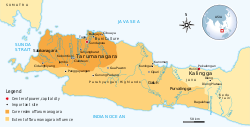Tarumanagara
| Tarumanagara | ||||||||||||||
|
||||||||||||||
|
The territory of Tarumanagara
|
||||||||||||||
| Capital | Sundapura (near Tugu, Jakarta and Bekasi) | |||||||||||||
| Languages | Sundanese, Sanskrit | |||||||||||||
| Religion | Hinduism, Buddhism, Animism, Sunda Wiwitan | |||||||||||||
| Government | Monarchy | |||||||||||||
| History | ||||||||||||||
| • | Established | 358 | ||||||||||||
| • | Sriwijaya invasion in 650 | 669 | ||||||||||||
|
||||||||||||||
Tarumanagara or Taruma Kingdom or just Taruma is an early Sundanese Indianised kingdom, whose 5th-century ruler, Purnawarman, produced the earliest known inscriptions on Java island. The kingdom was located not far from modern Jakarta, and according to Tugu inscription Purnavarman apparently built a canal that changed the course of the Cakung River, and drained a coastal area for agriculture and settlement. In his inscriptions, Purnavarman associated himself with Vishnu, and Brahmins ritually secured the hydraulic project. Tarumanagara is believed was existed between 358–669 CE in Western Java region, in and around modern day Bogor, Bekasi and Jakarta, roughly corresponds to modern Greater Jakarta area.
The earliest known written records of Tarumanagara existence were inscribed in stone inscriptions. Inscribed stone is called prasasti in Indonesian. Numbers of stone inscriptions dated from Tarumanagara period was discovered in Western Java region.
In 1863, Dutch East Indies, a huge boulder of inscribed stone was spotted near Ciampea not far from Buitenzorg (Bogor). The stone inscription was discovered on the river bed of Ciaruteun river, a tributary of Cisadane River. It is today known as Ciaruteun inscription, dated from the 5th century, written in Vengi letters (used in the Indian Pallava period) and in Sanskrit language. This is the earliest inscription that clearly mentioned the kingdom's name "Tarumanagara". The inscription reports the most famous king of Tarumanagara.
"The powerful illustrious and brave King, the famous Purnawarman (of the) Tarumanagara (kingdom) whose (print of the) foot soles are the same (as those of) God Vishnu."
Located nearby is the Prasasti Kebon Kopi I, also called Telapak Gadjah stone, with an inscription and the engraving of two large elephant footprints. The inscription read: These elephant foot soles, akin to those of the strong Airwata (elephant, which God Indra used to ride), belongs to Tarumanagara King who is successful and full of control.
...
Wikipedia

